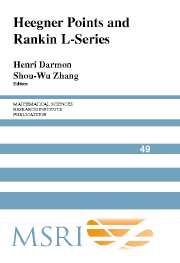Book contents
- Frontmatter
- Contents
- Preface
- Heegner Points: The Beginnings
- Correspondence
- The Gauss Class Number Problem for Imaginary Quadratic Fields
- Heegner Points and Representation Theory
- Gross–Zagier Revisited
- Special Value Formulae for Rankin L-Functions
- Gross–Zagier Formula for GL(2), II
- Special Cycles and Derivatives of Eisenstein Series
- Faltings Heights and the Derivative of Zagier's Eisenstein Series
- Elliptic Curves and Analogies Between Number Fields and Function Fields
- Heegner Points and Elliptic Curves of Large Rank over Function Fields
- Periods and Points Attached to Quadratic Algebras
Heegner Points and Elliptic Curves of Large Rank over Function Fields
Published online by Cambridge University Press: 06 July 2010
- Frontmatter
- Contents
- Preface
- Heegner Points: The Beginnings
- Correspondence
- The Gauss Class Number Problem for Imaginary Quadratic Fields
- Heegner Points and Representation Theory
- Gross–Zagier Revisited
- Special Value Formulae for Rankin L-Functions
- Gross–Zagier Formula for GL(2), II
- Special Cycles and Derivatives of Eisenstein Series
- Faltings Heights and the Derivative of Zagier's Eisenstein Series
- Elliptic Curves and Analogies Between Number Fields and Function Fields
- Heegner Points and Elliptic Curves of Large Rank over Function Fields
- Periods and Points Attached to Quadratic Algebras
Summary
Abstract. This note presents a connection between Ulmer's construction [Ulm02] of non-isotrivial elliptic curves over with arbitrarily large rank, and the theory of Heegner points (attached to parametrisations by Drinfeld modular curves, as sketched in Section 3 of Ulmer's article (see page ??). This ties in the topics in Section 4 of that article more closely to the main theme of this volume.
A review of the number field setting. Let K be a quadratic imaginary extension of F = Q, and let E/Q be an elliptic curve of conductor N. When all the prime divisors of N are split in K/F, the Heegner point construction (in the most classical form that is considered in [GZ], relying on the modular parametrisation X0(N)→ E) produces not only a canonical point on E(K), but also a norm-coherent system of such points over all abelian extensions of K which are of “dihedral type”. (An abelian extension H of K is said to be of dihedral type if it is Galois over Q and the generator of Gal(K/Q) acts by −1 on the abelian normal subgroup Gal(H/K).) The existence of this construction is consistent with the Birch and Swinnerton-Dyer conjecture, in the following sense: an analysis of the sign in the functional equation for shows that this sign is always equal to −1, for all complex characters χ of G := Gal(H/K). Hence
The product factorisation
implies that
so that the Birch and Swinnerton-Dyer conjecture predicts that
In fact, the G-equivariant refinement of the Birch and Swinnerton-Dyer conjecture leads one to expect that the rational vector spacecontains a copy of the regular representation of G.
It is expected in this situation that Heegner points account for the bulk of the growth of E(H), as H varies over the abelian extensions of K of dihedral type. For example we have:
Lemma 1. If ords=1L(E/H, s) ≤ [H : K], then the vector space E(H) ⊗ Q has dimension [H : K] and is generated by Heegner points.
Proof. For V any complex representation of G, let
Information
- Type
- Chapter
- Information
- Heegner Points and Rankin L-Series , pp. 330 - 361Publisher: Cambridge University PressPrint publication year: 2004
Accessibility standard: Unknown
- 1
- Cited by
